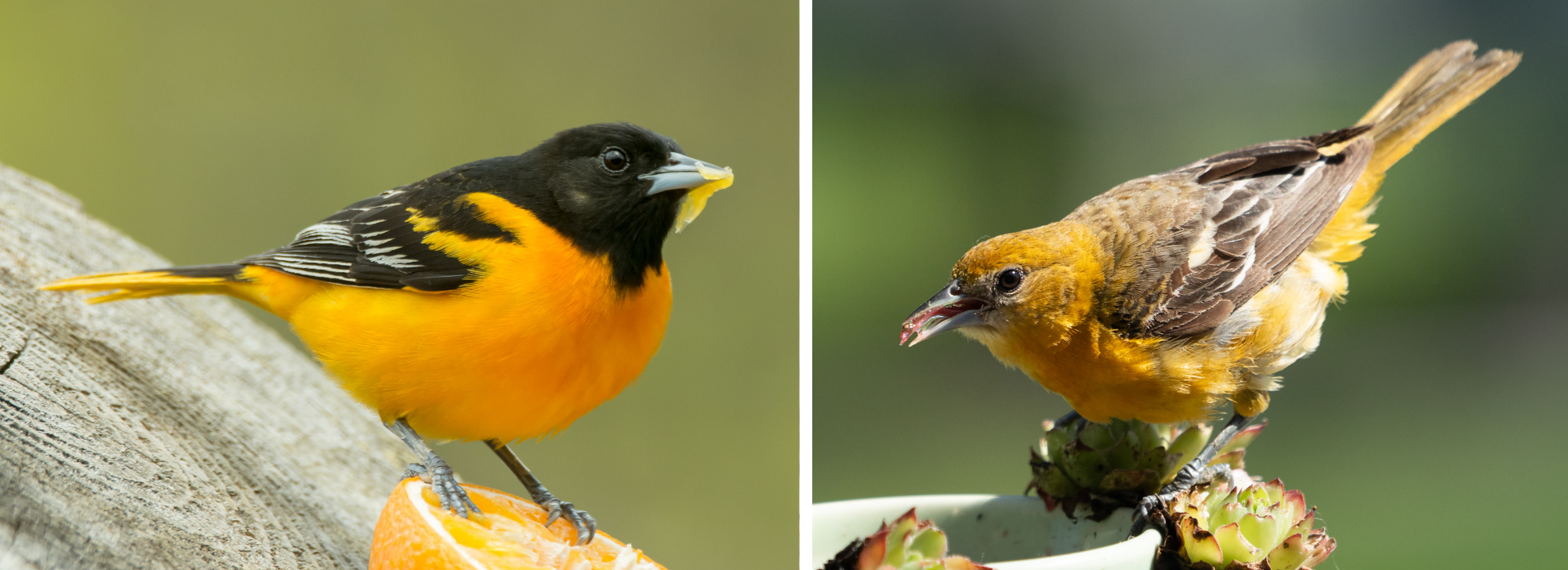Description and ecology
Baltimore Orioles (Icterus galbula) are large (~20 cm) migratory songbirds in the American Blackbird Family (Icteridae). Ontario has two native Oriole species, both of which breed in Ontario. The Orchard Oriole (Icterus spurius) is more localized in distribution, found in the southern Great Lakes Region, especially the Lake Erie Region, but seldom found further north. In contrast, the Baltimore Oriole is found throughout the Great Lakes Region. The Orchard Oriole is usually found in shrublands, savannas, and open forests, whereas the Baltimore Oriole prefer riparian hardwood forests with a scarce understory, though it can be observed in other forest types. The distribution of both species extends southwards throughout the eastern United States almost to the Gulf of Mexico.

Male Baltimore Orioles are vibrant orange, with a black head, black wings, and a white wingbar, arriving in the Great Lakes Region in early May, while the females arrive a few days later. Female orioles have varied plumage, from dull orange, to brown, to pale yellow, usually with grey wings. In the spring and early summer, Baltimore Orioles are quite vocal. Their song consists of a series of paired, melodic notes. The primary purpose of male birdsong is to attract a mate, and defend a breeding territory. Females may occasionally sing a few, irregular notes to communicate as well, but the more impressive songs are exclusively from the male Orioles. In July, these birds complete their nesting, and become much quieter, moving towards late summer foraging areas, while remaining in Ontario. By mid-August, Orioles are already migrating south, and by mid-September, the last ones leave migratory hotspots (Long Point, Rondeau Provincial Park, and Point Pelee National Park) for the year. Like Swallows (Hirundinidae) and other early migrants, if the Orioles are gone, it is a sure sign of the passing of summer. The wintering range encompasses the humid mountainous forests of Mesoamerica and the northern Andes.
These beautiful songbirds usually place their nests high up in the forest canopy, at the edges of branches away from the forest trunk. Trees with weeping, vase-like forms are preferred, especially White / American Elm (Ulmus americana), but also Eastern Cottonwood (Populus deltoides), Silver Maple (Acer saccharinum), and Red / Slippery Elm (Ulmus rubra). Their nest is unique, weaved into a basket-like shape. It is made often made of grass, grapevine bark, and animal hair. Nest construction takes 15 days and is entirely done by the female, the male bird defends the breeding territory and provides nesting materials. The clutch size is usually between 3-7 eggs, which are bluish-grey blotched with black or brown. Incubation takes 12 days, and another 12 days is needed to raise the nestlings to fledge. Since orioles usually only defend the area immediately adjacent to their nests, large groups of orioles nests are often observed in close proximity.
Orioles are omnivorous birds, although most of their dietary energy comes from insects. They are agile foragers, looking for insects in the canopies of trees, shrubs and other vegetation. They supplement their diet with fruit and nectar, readily visiting feeders in the summer months. While Orioles thrive in mature riparian forests, among the most species-rich in Ontario, they have also adapted well to human-modified landscapes, often observed in city parks, gardens, and arboretums.
Fun facts
- If you put orange peelings on a stick in May, you will attract Baltimore Orioles to your garden.
- Male Baltimore Orioles have an elaborate courtship display. They often bow, flash his bright plumage, and spread his tail to attract potential partners, monogamous within the same breeding season.
- Baltimore orioles fly thousands of kilometres from the Great Lakes Region to Mesoamerica and back again. They flight right over the Gulf of Mexico without stopping. This is why accumulating energy reserves in late summer is especially important for migratory songbirds.
- Orioles moult twice a year. Their largest moult is in late summer (July-August), where these birds replace all their feathers, called a pre-basic moult by ornithologists. The other moult, termed the pre-alternate moult, occurs in February, where Orioles will replace part of their feathers, showcasing their vibrant summer plumage when moulting is completed.

